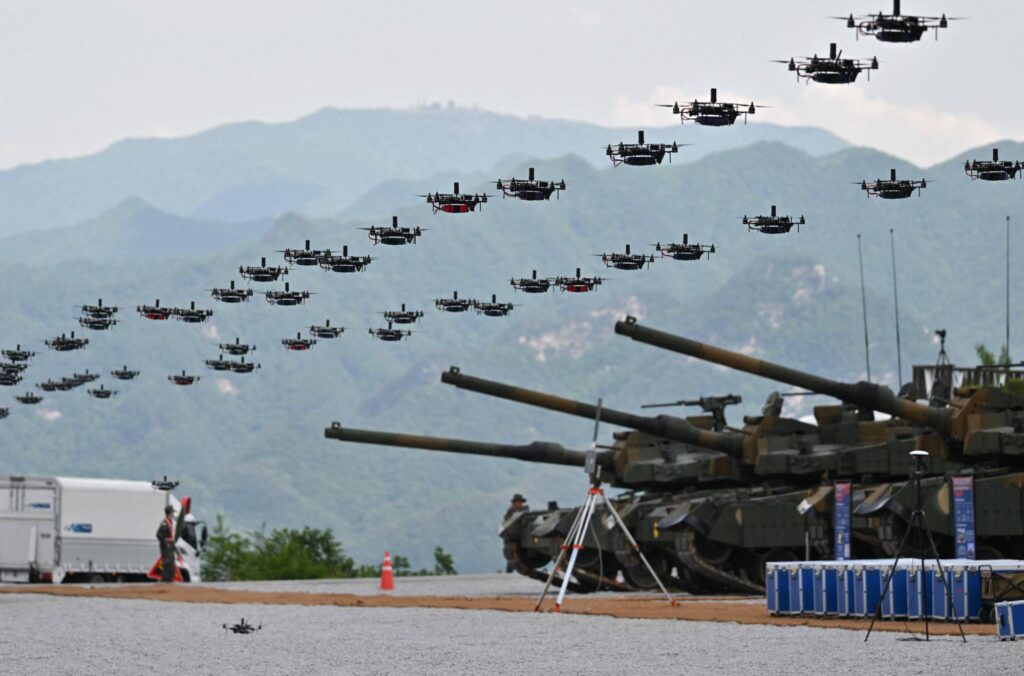On May 1, 2024, under the leadership of President Yoon Suk Yeol, the South Korean government announced its intention to significantly increase its number of military drones by 2026, as reported by the Korea Herald on May 2, 2024
his initiative aims to strengthen South Korea’s military readiness in the face of growing threats from North Korean unmanned aerial vehicles. The announcement was made during a meeting of the Defense Innovation Committee chaired by National Security Advisor Chang Ho-jin.
During the Combined Joint Live-Fire Exercise between South Korea and the United States at the Seungjin Fire Training Field in Pocheon, Gyeonggi Province, just 25 kilometers south of the inter-Korean border on May 25, South Korea’s military drones flew in formation (Picture source: South Korean MoD)
During the meeting, it was decided to diversify acquisition methods by accelerating the purchase of locally produced commercial drones and rapidly deploying drones currently in the research and development phase. The goal is to actively integrate them into combat operations. Additionally, an increase in budget allocations was planned to facilitate this rapid acquisition, although specific details about the types of drones or the amounts involved were not disclosed.
This decision follows the establishment, in September, of the Drone Operations Command in Pocheon, a town in Gyeonggi Province near the border with North Korea. This military unit was established in response to a North Korean military provocation in December 2022, during which North Korean drones entered South Korean airspace near Seoul before returning to North Korea.
South Korea has developed several drone models to meet various military needs. Among the most notable is the KUS-FS, a surveillance and reconnaissance drone developed by Korea Aerospace Industries (KAI). Capable of conducting extensive surveillance missions, this drone plays a crucial role in intelligence gathering.
Another important model is the KAI KUS-MA, a smaller drone designed for short-range tactical missions. This drone can be used for surveillance, reconnaissance, and even strike missions, thanks to its ability to carry light payloads.
South Korean drones are primarily used for surveillance and reconnaissance. This includes monitoring border areas, reconnaissance in enemy territory without risking human lives, and assessing damage after conflicts or natural disasters. Moreover, with advancements in technology, drones capable of conducting targeted strikes are also being developed, thereby enhancing the offensive capabilities of the South Korean military.
South Korea has established several international partnerships for the development and production of drones. For example, collaborations with the United States and European countries are in place to share advanced technologies and co-develop new systems. These partnerships not only help improve the quality of the drones produced but also ensure they meet international defense standards.
Additionally, interest in South Korean military drones has grown on the international stage. Countries in Southeast Asia, as well as some of South Korea’s traditional allies, have expressed interest in acquiring South Korean drones, attracted by their advanced technology and competitive cost. This growing demand has allowed South Korea to position itself as a significant player in the global military drone market.
The committee, which includes ten members, including Chang, Defense Minister Shin Won-sik, and eight civilians such as former Defense Minister Kim Kwan-jin, also discussed ways to improve combat effectiveness. It was reported that government funding for weapons modernization programs will represent 5% of the total state budget, an increase from the current level of 1%, to enhance the South’s defense capabilities.
Since its establishment in May 2023, the Defense Innovation Committee has met four times, with the first three meetings chaired by Yoon. This initiative is part of a series of efforts to strengthen South Korea’s defensive posture in the face of regional and global challenges.


